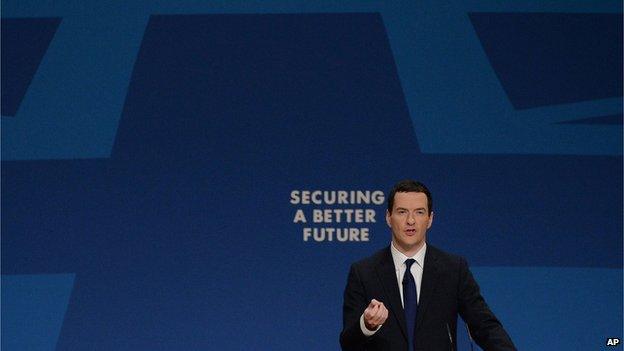Welfare Freeze: Who Would Be Hit?
- Published
- comments

Cutting welfare goes down well with voters. But it is notoriously difficult to achieve meaningful savings without hurting the very people you are looking to support and encourage.
So it is with George Osborne's announcement today. The proposed freeze on working-age benefits, if the Conservatives are elected in 2015, looks eye-catching. But its effect may cause some to reflect.
The Chancellor calculates that it will save £3.2bn over two years, 2016/17 and 2017/18. Treasury figures suggest the total welfare bill across those two years will be roughly £356bn - so the saving would amount to about 0.9% of the total.
To put it another way, the freeze would not affect 99.1% of welfare spending. Nevertheless, £3bn is not an insignificant sum and some will argue it would be an important contribution to cutting the deficit.
The question, however, is whether the real-terms cut targets the right people. Around two-thirds of those affected by the freeze are in working households. Government figures show that some 67% of those receiving child or working tax credits are designated to be "in-work families". Most of those in receipt of child benefit will also be working.
It will also hit some of the poorest families in Britain. Income Support, which is included in the freeze, is a benefit specifically targeted at the poor. Child benefit can be the difference between just getting by and going without the basics for some low-income families.
The freeze, then, saves a fraction of total welfare spending and predominantly hits low-income "hard-working families", as politicians like to describe them.
The Conservatives came to power promising to eradicate child poverty by 2020 and "build an economy that delivers for people who work hard".
Part of the problem is that the public have a misplaced idea of what the benefits budget is actually spent on. Slightly more than half of it goes to pensioners. Out of a total welfare bill of £168bn this year, £86.5bn is spent on the state pension alone. The over 65s have proved to be the untouchables when it comes to welfare reform.
.jpg)
Jobseekers Allowance, by comparison, is estimated to be £3.4bn this financial year - just 2% of the total benefits spend. Indeed, the annual cost of JSA has fallen by £1.1bn during the current parliament, while expenditure on the state pension is now £16.5bn higher than in 2010/11.
The other proposed benefits reform announced by the chancellor was a cut to the welfare cap, the maximum amount a working-age household can claim in benefits. Currently at £26,000 a year, the intention is to reduce that to £23,000 - approximately £58 a week less.
Mr Osborne can argue that benefits have risen faster than wages over the past few years and so the reduction - based on the average incomes of a working household - is fair.
The welfare cap has proved a popular policy amid stories of huge families living in state-funded "mansions". However, the government concedes that the savings are modest - around £300m a year, or 0.2% of the benefits budget.
Moving the annual welfare cap down by £3,000 will increase the savings but it is unlikely to make any serious in road into the benefits bill or the deficit.
The point about today's announcements is less their impact on welfare spending and more their impact on the fast-approaching general election campaign.